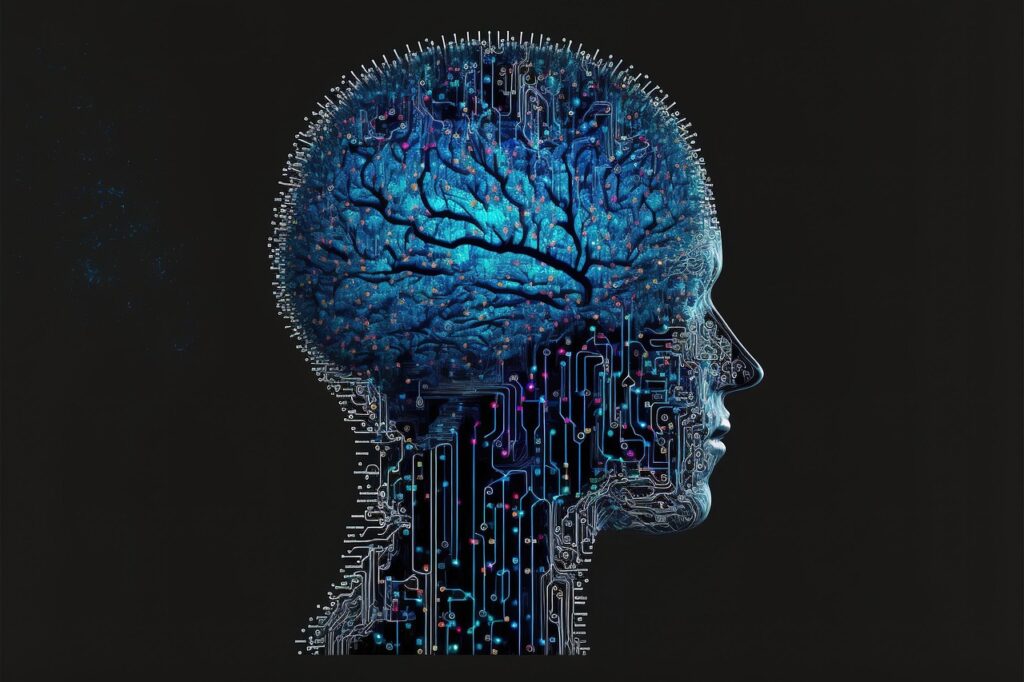A New Kind of Classroom
The bell rings and the classroom buzzes as students settle in. Ms. Rivera opens her laptop and an interactive lesson begins. Beside her, an AI assistant quietly updates each student’s progress. Instead of replacing Ms. Rivera, the AI helps her see who needs extra support. This small scene shows how AI is already changing learning without taking away the human heart of teaching.
Teachers everywhere wonder if AI will someday take their jobs. Recent surveys show that more than 60 percent of educators already use some form of AI tools to grade quizzes or suggest lesson ideas (Smith 2024). While these programs save time, they cannot replace the warmth and understanding a teacher brings. Students still look to their teachers for encouragement, guidance, and real conversation.
The scholarly sphere of education research notes that AI works best as a partner, not a rival (Lopez 2023). AI can scan large amounts of data quickly, helping teachers personalize lessons. For example, if a student struggles with fractions, AI-driven programs can spot the problem early and give practice activities right away. This allows teachers to spend more time connecting with students and less time buried in paperwork.
Below is a simple table showing what teachers and AI each do well:
| Task | Teachers | AI |
|---|---|---|
| Emotional support | ✔️ Strong | ❌ Limited |
| Instant data analysis | ❌ Slow | ✔️ Fast |
| Creative lesson planning | ✔️ Human creativity | ⚪ Assists but not original |
| Adapting to unexpected events | ✔️ Flexible | ❌ Follows set rules |
Teachers bring empathy and moral guidance that machines can’t match. AI may help with grading or practice exercises, but it doesn’t understand a shy student’s nervous smile or know how to inspire a love for literature.
Key points to remember:
- AI is a helpful tool, not a full replacement.
- Teachers give emotional and social support that technology lacks.
- Working together, teachers and AI can create a richer classroom experience.
Our blog offers stories and articles like this to help students, teachers, parents, and all learners see how education is changing. With the right balance, AI can be a powerful teammate, allowing teachers to focus on what matters most: guiding young minds.
What the Research Says: Can AI Replace Teachers?

The question of whether AI will replace teachers keeps many students, parents, and educators curious and sometimes worried. Research shows AI is growing fast in classrooms, yet its limits make full replacement very unlikely. Let’s look closely at how AI is being used, what it does well, where it falls short, and what that means for everyone involved in learning.
AI’s Rapid Growth in Schools
AI is already a regular part of many schools. A study by Microsoft and IDC shows that 86 percent of education organizations now use generative AI, the highest adoption rate among major industries (Microsoft/IDC 2025).
A Gallup survey of more than two thousand U.S. teachers found nearly 60 percent used AI tools during the past school year, mainly to make worksheets, modify student materials, and create tests. Teachers who used AI weekly saved about six hours per week (Gallup 2025).
Another poll revealed that teachers using AI at least weekly saved an average of 5.9 hours weekly, equal to about six extra weeks of work across a school year (Walton Family Foundation 2025).
Typical tasks include preparing lessons (37 percent), creating worksheets (33 percent), adapting materials for special needs (28 percent), administrative chores (28 percent), and designing assessments (25 percent) (Walton Family Foundation 2025).
Educator attitudes are also improving: 93 percent of teachers in a Carnegie Learning survey found AI helpful in 2025, up from 77 percent in 2024 (Carnegie Learning 2025).
Student use of AI for school jumped by 26 percentage points in a single year, while teacher use rose by 21 points (Microsoft 2025).
These numbers show how quickly AI is becoming part of everyday school life, especially for repetitive or data-heavy work. But high usage does not mean educators believe AI will replace them.
Where AI Helps the Most
AI shines when tasks are repetitive, data-driven, or easily automated.
| Area | How AI Helps |
|---|---|
| Routine tasks | Automates grading for multiple-choice questions, generates worksheets and assessments, and saves hours each week (Gallup 2025). |
| Personalized learning | Tracks student progress, spots weaknesses early, and offers tailored exercises (Microsoft 2025). |
| Tutoring & access | Provides 24/7 help for homework or test prep, useful for large classes or remote learning (APA 2025). |
| Teacher efficiency | Frees teachers for creative planning, one-on-one support, or professional growth (Gallup 2025). |
Teachers say these strengths let them focus on real teaching—discussion, mentoring, and motivating students.
Where AI Falls Short
Despite its strengths, AI has limits that keep human teachers essential.
- Emotional connection – Teachers sense a student’s excitement, confusion, or anxiety in ways AI cannot (Lopez 2023).
- Complex judgment – Handling open-ended essays, moral dilemmas, or sudden classroom issues requires nuanced human judgment (Smith 2024).
- Creativity – Teachers inspire curiosity and design projects that spark imagination; AI mainly recombines existing information (Carnegie Learning 2025).
- Adaptability – Humans adjust to sudden events like fire drills, community crises, or a student meltdown, while AI follows fixed patterns (APA 2025).
- Training gaps – Less than half of teachers feel they “know a lot” about AI, even while using it regularly (Microsoft 2025).
- Equity issues – Schools with less funding may lack hardware, internet, or staff training, creating unequal opportunities (U.S. Department of Education 2025).
- Ethics and bias – AI systems can reflect bias in their training data and sometimes generate false or harmful content (OECD 2024).
These weaknesses show why AI is more of a teammate than a replacement.
What Researchers Predict

Most experts believe AI will change teaching, not replace teachers.
Educators overwhelmingly see AI as a partner (Gallup 2025). Analysts predict a hybrid model, with AI handling grading and data while teachers focus on mentoring, social-emotional learning, and creative instruction (Cengage Group 2025).
The scholarly sphere of education research also finds that AI works best when teachers remain central (Lopez 2023).
Real-World Examples
- South Australia’s EdChat uses AI to help with grading and planning but never intended it to replace teachers (Adelaide Education Dept. 2025).
- Estonia’s AI Leap provides students with AI tools and trains teachers to enhance critical thinking, not to remove educators (Estonian Ministry of Education 2025).
- Illinois Teach Plus Group found that 92 percent of teachers see AI’s benefits but want clear policies to keep human educators essential (Teach Plus 2025).
- Singapore’s Smart Classroom Pilot blends AI lesson planners with human teachers to personalize learning without cutting staff (Tan 2024).
- Finland’s National AI Literacy Program trains teachers to use AI responsibly while keeping students’ well-being first (Helsinki Education Board 2024).
- South Korea’s AI Tutoring Project integrates AI tutors for after-school support, but always under a teacher’s guidance (Kim 2024).
These cases show that governments and schools use AI as a support system rather than a substitute.
Impact on Students, Teachers, Parents, and Learners
| Group | Likely Outcome | How Blogs & Articles Help |
|---|---|---|
| Teachers | Less time on paperwork, more time mentoring; evolving roles rather than replacement | Provide guides and stories on blending AI with teaching |
| Students | More personalized feedback and extra help; need to avoid over-reliance | Offer tips on critical thinking and responsible AI use |
| Parents | Hope for improved outcomes but concerns about screen time and privacy | Share explainers on AI’s role and school policies |
| Learners in general | Chance to develop AI skills and digital literacy; risk of unequal access | Highlight resources for equitable AI learning |
Barriers to Overcome
- Policy gaps – Schools need clear rules on privacy, bias, and plagiarism (U.S. Department of Education 2025).
- Trust – Students and parents must trust that AI aids rather than replaces teachers (OECD 2024).
- Funding – Adequate tech infrastructure and training require investment (World Bank 2024).
- Professional development – Teachers need time and support to learn AI tools while maintaining teaching quality (Carnegie Learning 2025).
Big Picture
All major studies point to the same conclusion: complete replacement of teachers by AI is very unlikely anytime soon.
Instead, teacher roles will evolve. AI will handle repetitive tasks and complex data, while teachers guide, inspire, and nurture human growth—things machines can’t replicate.
Looking Ahead: Humans and AI, Side by Side

Imagine a classroom ten years from now. Students get instant feedback on practice quizzes from an AI helper while their teacher moves around the room, asking questions and sharing stories. This picture shows the most likely future of education: humans and AI working together.
Teachers will still guide learning in ways machines can’t. They notice when a student is worried even before a word is spoken. They turn a dry lesson into an exciting game or tell a story that sticks forever. Empathy, creativity, and the ability to inspire belong to people, not code. AI might speed up grading or create practice questions, but it can’t replace the trust and connection that teachers build every day.
For students and parents, this partnership offers many benefits—if used wisely. Students get quick feedback and lessons matched to their needs. Parents can track progress and spend less time worrying about missed assignments. But families must also watch for issues like too much screen time, privacy risks, and unequal access so that technology helps everyone instead of leaving some learners behind.
Teachers need strong support as their roles change. Training and planning time are key so they can use AI without losing the heart of their work. Schools that invest in professional development and clear policies will help teachers stay in charge of learning while letting technology handle routine tasks. Blogs and articles about education can guide teachers, parents, and students through these changes by sharing real success stories and lessons learned.
The scholarlysphere reminds us that great teaching is about relationships and curiosity, not just information. As AI grows, it should serve as a tool that frees teachers to focus on those deeper goals. Students will remember the people who believed in them and celebrated their progress long after they forget which app corrected their grammar.
Key Takeaways
- Human touch matters: Empathy and creativity can’t be automated.
- AI is a partner, not a boss: It supports teachers instead of replacing them.
- Training is essential: Teachers need time and resources to use AI well.
- Equity counts: Schools must ensure all students have equal access.
- Policies protect privacy: Clear rules keep data and student safety in focus.
Quick Action Steps
- For Teachers
- Learn at least one new AI tool each semester.
- Use AI for grading or prep to save time for mentoring.
- Share best practices with colleagues.
- For Students
- Use AI for practice and feedback, but double-check answers.
- Balance screen time with real-world activities.
- Ask teachers how to use AI responsibly.
- For Parents
- Ask schools about privacy policies and AI tools in use.
- Encourage critical thinking about technology.
- Support balanced tech habits at home.
The future of education isn’t about choosing humans or machines—it’s about using both wisely. Teachers will stay at the center while AI becomes a helpful partner that makes learning richer and more flexible. The question isn’t whether AI will replace teachers; it’s how we can shape this partnership so every student thrives.
Are you ready to help build that future together?
Works Cited
Adelaide Education Dept. South Australia’s AI Chatbot in Classrooms. 2025,
https://www.adelaidenow.com.au/education/support/technology-digital-safety/report-reveals-how-sa-public-school-students-are-using-education-departments-official-ai-chatbot-in-class/news-story/594fd4566f1aa6632716573e7c853c65.
American Psychological Association. “Trends in Classrooms & Artificial Intelligence.” Monitor on Psychology, Jan. 2025,
https://www.apa.org/monitor/2025/01/trends-classrooms-artificial-intelligence.
Carnegie Learning. 2025 State of AI in Education. 2025,
https://discover.carnegielearning.com/hubfs/PDFs/Whitepaper%20and%20Guide%20PDFs/2025-AI-in-Ed-Report.pdf.
Cengage Group. “AI’s Impact on Education in 2025.” Cengage Group News, 2025,
https://www.cengagegroup.com/news/perspectives/2025/ais-impact-on-education-in-2025/.
Estonian Ministry of Education. “National AI Leap in Schools.” Financial Times, 2025,
https://www.ft.com/content/897c43a1-e366-415e-9472-4607604aa483.
Gallup. “Survey: 60% of Teachers Used AI and Saved Up to 6 Hours a Week.” The 74 Million, 2025,
https://www.the74million.org/article/survey-60-of-teachers-used-ai-this-year-and-saved-up-to-6-hours-of-work-a-week/.
Helsinki Education Board. “Finland’s National AI Literacy Program.” Yle News, 2024,
https://yle.fi/a/74-20055234.
Kim, J. “South Korea’s AI Tutoring Project.” The Korea Times, 2024,
https://www.koreatimes.co.kr/www/nation/2024/09/181_363992.html.
Microsoft and IDC. 2025 AI in Education Report. Microsoft, 2025,
https://cdn-dynmedia-1.microsoft.com/is/content/microsoftcorp/microsoft/bade/documents/products-and-services/en-us/education/2025-Microsoft-AI-in-Education-Report.pdf.
Organisation for Economic Co-operation and Development. AI and Bias in Education. OECD, 2024,
https://www.oecd.org/education/ai-in-education-bias-privacy.pdf.
Tan, L. “Singapore’s Smart Classroom Pilot.” The Straits Times, 2024,
https://www.straitstimes.com/singapore/education/singapore-smart-classroom-pilot-ai-2024.
Teach Plus Illinois. “Call for Statewide AI Policy.” Jacksonville Journal-Courier, 2025,
https://www.myjournalcourier.com/news/article/teach-plus-calls-illinois-government-ai-policy-20136318.php.
U.S. Department of Education. Artificial Intelligence and the Future of Teaching Report. 2025,
https://www.ed.gov/sites/ed/files/documents/ai-report/ai-report.pdf.
Walton Family Foundation. The AI Dividend Survey. 2025,
https://www.waltonfamilyfoundation.org/the-ai-dividend-new-survey-shows-ai-is-helping-teachers-reclaim-valuable-time.
World Bank. Technology and Education Equity Report 2024. 2024,
https://documents.worldbank.org/en/publication/documents-reports/documentdetail/099430003012423379/p1798850b0d4590a4089ea0b79c4f56a63.


